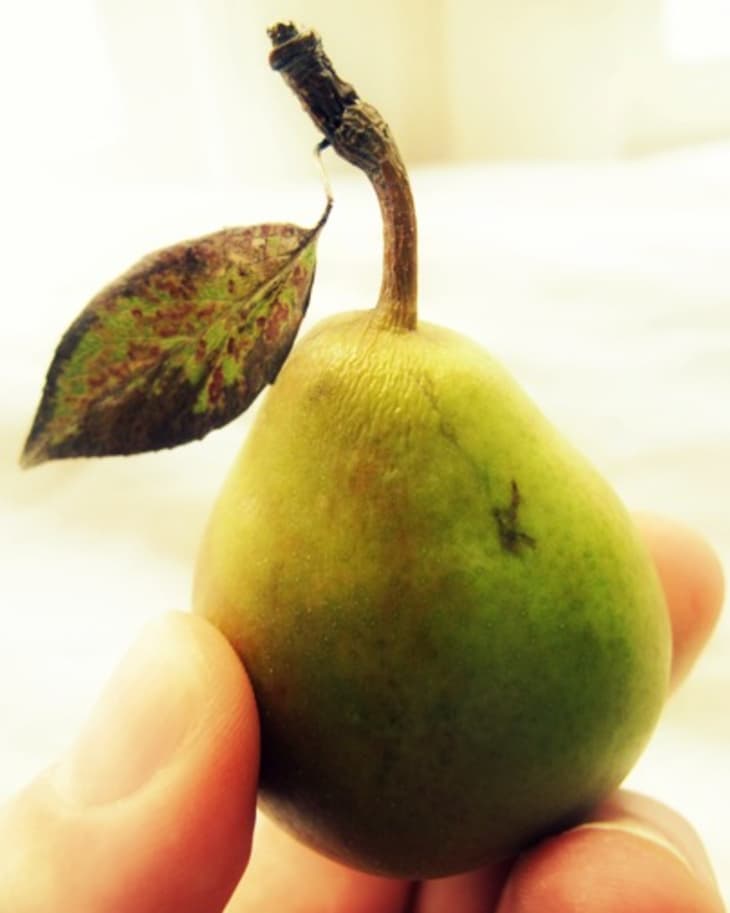Pears! 7 Common Types and How to Use Them
If you’re browsing your local farmer’s market, you’ll probably see more than seven types of pears. You may even discover a totally new (and vaguely unpronounceable) variety that becomes your favorite. But for now, let’s talk basics. What’s the difference between a Bartlett and a Bosc? And which one should you pick up for your afternoon snack?
These seven types of pears are what we see most often at the grocery store. To be honest, a lot of them look (and taste) alike, and you can certainly use them interchangeably. But some really need to ripen to a perfect point before they taste sweet; others should be eaten when they’re still a bit hard.
• For pictures of each variety (plus a few extra we’re not highlighting here), check out the website of the Pear Bureau Northwest: usapears.org.
7 Common Varieties of Pears
ANJOU: Anjou pears can be green or red. They’re squatty, with a round shape and a thicker stem that’s kind of nestled into the neck. They are basic, all-purpose pears. You can snack on them (they’re ripe when they give to gentle pressure around the stem), put them in salads, or bake with them.
ASIAN: Yes, this is a catchall for a wide range of asian pears. If you want to read about different varieties, check out
this excellent post
BARTLETT: This is the pear most of us got in our lunchboxes as kids. It has the classic pear shape and lime green to yellow skin (more golden when it’s super ripe). Bartletts are sweet, soft, and delicious, but you have to be careful they don’t get too ripe. They can go mushy (and bruise) pretty fast. For that reason, we prefer to save these for snacking. If we bake with them, we make sure they’re not quite ripe.
BOSC: Bosc pears are the most distinctive; you can spot them right away. They’re the ones with the long, skinny necks and thick, brownish skin. Their flavor can be wonderful—deep and densely sweet—but we sometimes find it hard to capture. Bosc pears can be tough and tasteless when they’re not perfectly ripe (the skin is a bit tough, too), but they don’t need to be soft to be ripe, so it can be hard to tell. We’d save these for baking.
COMICE: These guys are fat and round with short necks and thick stems. Most comice pears are green but can have red streaks as they ripen. Their flesh is often described as “creamy,” and the usapears website recommends serving them on a cheese plate. We like to eat these out of hand; they’re a great shape to hold.
CONCORDE: Truth be told, we don’t see a lot of concorde pears in our grocery store, but we’re including them for this interesting fact: Apparently they don’t brown very much when you slice them. Anyone have any experience with this? Is it true?If so, they’d be great for green salads or fruit salads. And like Bosc pears, they have long, tapered necks and don’t need to be soft to be ripe.
SECKEL: Oh, we love itty bitty seckel pears (pictured at top). They are only in the markets for a short time, and they’re perfectly sweet when they’re ripe (not so tasty when they aren’t). We’ve used these mini pears for place card settings, and there are some desserts that call for whole seckel pears (check out the top one in this post). But they don’t have a ton of flesh to work with, so we usually save them as snacks.
What is your favorite type of pear?
(Images: Dana Velden; Gregory Han)
